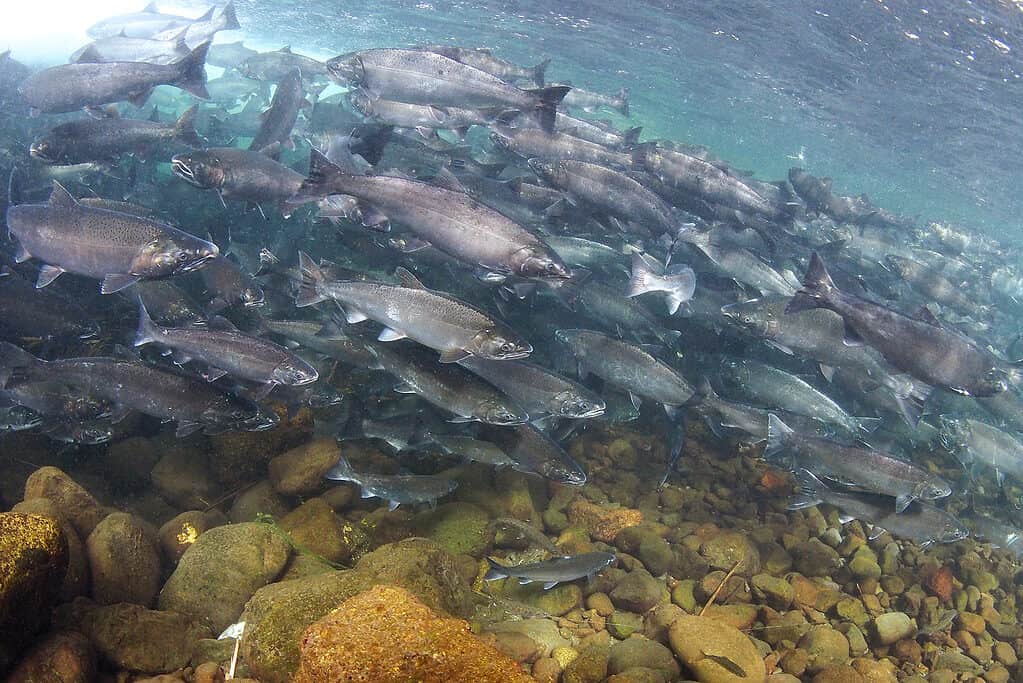The Klamath River spans two states, Oregon and California. Its deepest point is in Upper Klamath Lake, which ranges from 8-50 feet deep. This depth is similar to Oregon’s Willamette River, in the northern part of the state. Other portions of the Klamath River are 20 feet deep. Contrast this with Oregon’s deepest river, the Columbia — which can run 1000 feet deep!
The Klamath River has a history of flooding, with five major floods in the last 100 years. Closer to where it ends in the Pacific Ocean, the river is also at risk of tsunami surges.

Upper Klamath Lake is one of the best sailing lakes in North America. It also boasts huge rainbow trout!
©iStock.com/4nadia
Klamath River Basics
The Klamath River runs through southern Oregon and the northernmost part of California on its way to the Pacific Ocean. The river is 250-270 miles long, depending on where you locate its headwaters. While many rivers originate in mountains, the Klamath River originates in the high desert east of the Cascade Mountains. The Klamath River (or Ishkêesh in the Karuk language) is federally protected as a “wild and scenic river.”

Coho is one species of salmon that calls the Klamath River home.
©USFWS – Pacific Region / Flickr – License
Salmon runs on the Klamath River were once the third largest in the U.S. Now they are at only 8% of their historic maximums, in part due to dams constructed between 1908 and 1962. Fish that depend on the Klamath River for survival and habitat include Chinook and coho salmon, steelhead and coastal cutthroat trout, green and white sturgeon, and Pacific lamprey.
Why Does the Klamath River Matter?

Fly fishing is just one of the many recreational opportunities on the Klamath River.
©EvanKilgore/Shutterstock.com
Western Rivers Conservancy says, “The Klamath is unmatched on the West Coast for its combination of wild and free-flowing sections, intact forests and marshes, surviving native fish runs and spectacular recreation.”
Migrating birds stop in its natural wetlands along the Pacific Flyway. There is also a salmon sanctuary on the lower Klamath River. Forests along the Klamath provide habitat for over 400 species of wildlife and about 1000 different kinds of plants. Whether you prefer birding, fly fishing, or whitewater rafting, the Klamath River has something for you!
Restoring the Klamath River

The reservoir at the Iron Gate Dam on the Klamath River in California is one of the dams to be removed.
©davidrh/Shutterstock.com
Various groups have fought since 2000 to restore the Klamath River to a more natural state. Conservation agency American Rivers collaborated with Swiftwater Films and local Indigenous leaders to create a film about this process. Beyond that, “Guardians of the River” profiles those who advocate for the removal of hydroelectric dams along the Klamath River.
Expected benefits of these conservation efforts include cleaner water, climate resilience, and restoration of salmon habitat. Having more salmon helps local tribes and also ocean-migrating orcas; salmon is an essential food for both. Indigenous peoples also care for the Klamath River, including the Yurok, Karuk, Hoopa, Shasta, and Klamath tribes.
The decommissioning of four hydroelectric dams is scheduled to begin in 2023.
The photo featured at the top of this post is © ellen joy mercado/Shutterstock.com
Thank you for reading! Have some feedback for us? Contact the AZ Animals editorial team.






